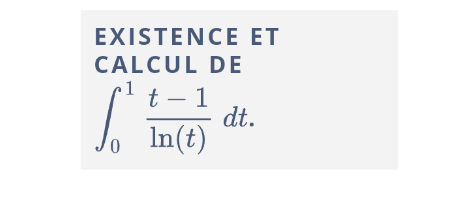Question Number 182219 by SANOGO last updated on 05/Dec/22

Answered by Ar Brandon last updated on 06/Dec/22
![Sea I(α)=∫_0 ^1 ((t^α −1)/(lnt))dt Derivando con respecto a α obtenemos I ′(α)=∫_0 ^1 ((t^α lnt)/(lnt))dt=∫_0 ^1 t^α dt=[(t^(α+1) /(α+1))]_0 ^1 =(1/(α+1)) Ahora integrando con respecto a α obtenemos I(α)=∫(1/(α+1))dα=ln(α+1)+C Pero I(0)=∫_0 ^1 ((t^0 −1)/(lnt))dt=0=ln(0+1)+C ⇒C=0 ⇒I(α)=ln(α+1) ∫_0 ^1 ((t−1)/(lnt))dt=I(1)=ln(2)](https://www.tinkutara.com/question/Q182222.png)
$$\mathrm{Sea}\:{I}\left(\alpha\right)=\int_{\mathrm{0}} ^{\mathrm{1}} \frac{{t}^{\alpha} −\mathrm{1}}{\mathrm{ln}{t}}{dt} \\ $$$$\mathrm{Derivando}\:\mathrm{con}\:\mathrm{respecto}\:\mathrm{a}\:\alpha\:\mathrm{obtenemos} \\ $$$${I}\:'\left(\alpha\right)=\int_{\mathrm{0}} ^{\mathrm{1}} \frac{{t}^{\alpha} \mathrm{ln}{t}}{\mathrm{ln}{t}}{dt}=\int_{\mathrm{0}} ^{\mathrm{1}} {t}^{\alpha} {dt}=\left[\frac{{t}^{\alpha+\mathrm{1}} }{\alpha+\mathrm{1}}\right]_{\mathrm{0}} ^{\mathrm{1}} =\frac{\mathrm{1}}{\alpha+\mathrm{1}} \\ $$$$\mathrm{Ahora}\:\mathrm{integrando}\:\mathrm{con}\:\mathrm{respecto}\:\mathrm{a}\:\alpha\:\mathrm{obtenemos} \\ $$$${I}\left(\alpha\right)=\int\frac{\mathrm{1}}{\alpha+\mathrm{1}}{d}\alpha=\mathrm{ln}\left(\alpha+\mathrm{1}\right)+{C} \\ $$$$\mathrm{Pero}\:{I}\left(\mathrm{0}\right)=\int_{\mathrm{0}} ^{\mathrm{1}} \frac{{t}^{\mathrm{0}} −\mathrm{1}}{\mathrm{ln}{t}}{dt}=\mathrm{0}=\mathrm{ln}\left(\mathrm{0}+\mathrm{1}\right)+{C}\:\Rightarrow{C}=\mathrm{0} \\ $$$$\Rightarrow{I}\left(\alpha\right)=\mathrm{ln}\left(\alpha+\mathrm{1}\right) \\ $$$$\int_{\mathrm{0}} ^{\mathrm{1}} \frac{{t}−\mathrm{1}}{\mathrm{ln}{t}}{dt}={I}\left(\mathrm{1}\right)=\mathrm{ln}\left(\mathrm{2}\right) \\ $$
